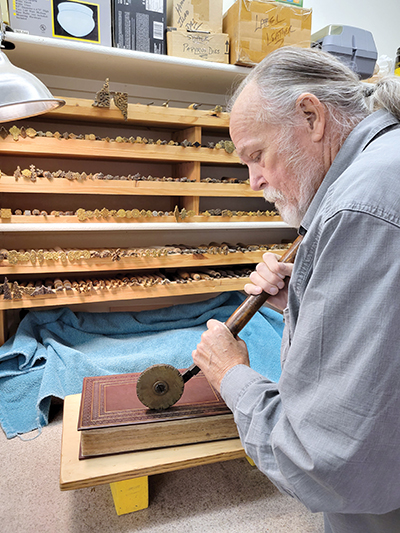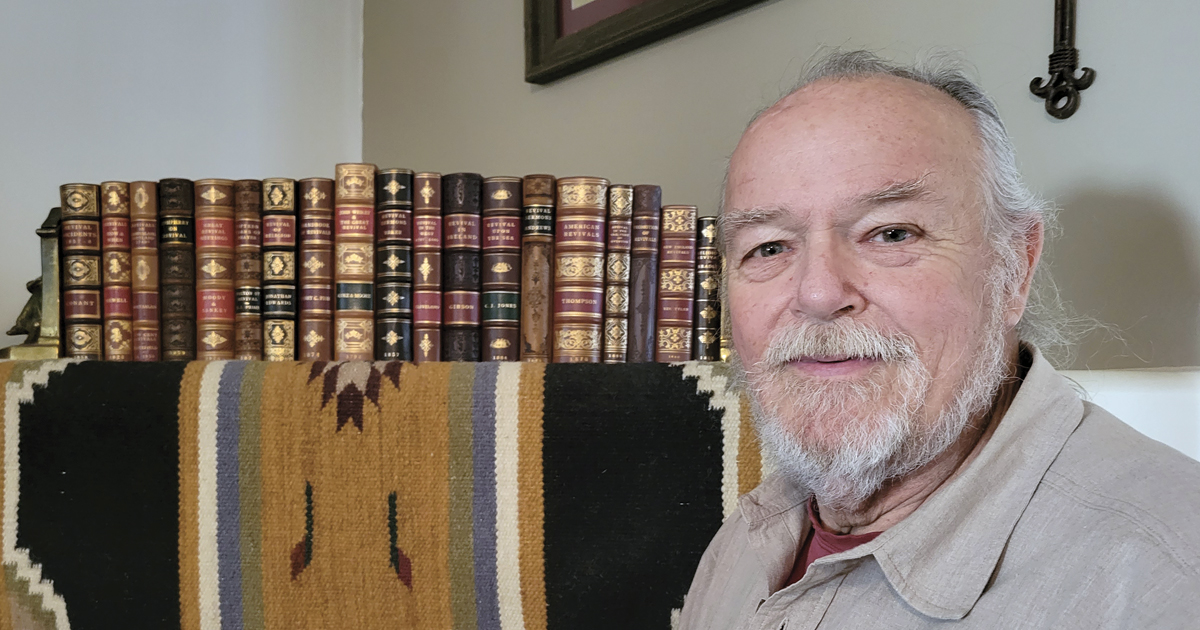“I paid a quarter for my first book,” Chris Starr says. It was a small volume by 19th-century English poet and hymnwriter Frances Ridley Havergal, entitled Kept for the Master’s Use.
Chris never imagined that his hobby would turn into a full-time business for himself, his wife, Donna, and their daughter, Samantha.
DIY Restoration
It all started after Chris’ conversion to Christianity when he started going to a church where one of the pastors had an extensive collection of old religious volumes.
He had the desire, if not the wallet, for collecting his own rare and antique books. Chris was working as a truck mechanic while conducting street and prison ministry, and Donna had become the financial administrator for their church.
“But we both have a deep love for books,” Donna smiles.
“In everything we do, we try to do the best work for a fair price. We’re not trying to get rich.” DONNA STARR
Their desire to learn led them to become regulars at antiquarian book fairs, gradually accumulating their own collection.
Many of the books they acquired needed restoration, but they couldn’t find anyone who knew how to do it properly. That drove Donna to learn how to do it herself. She began by experimenting on Chris’ books, taking some of them apart and figuring out how to fix them on her own.
She later studied at Creative Arts Workshop in New Haven, Connecticut, for two years with Gisela Nowik, a conservator at Yale University’s rare books library. She also took classes at the Center for Book Arts in New York City.
“We started off binding books just for ourselves and friends,” says Donna. “Then we did some work for a dealer. Before long, we had a business on our hands.” They officially became Starr Bookworks in 1991.
Both kept working their full-time jobs and doing book repairs on the side. Chris finally quit his full-time job to concentrate on the book business, which at that time included buying and selling antique books online. As the bindery workload increased, Donna left her job, too.
Word-of-Mouth Success
About 20 years ago, they moved themselves and Starr Bookworks from Connecticut to Arizona. Across the breezeway from their house is an oversized two-car garage that became their new bindery.
The Starrs don’t broadcast their deep faith, but it shows up in their business practices. And that holds true even when it may result in a loss of income, such as when the estimated cost they quoted to a customer turns out to be too low. (The job may be more extensive than expected or the cost of materials may have gone up.)
“We have always stuck to the prices quoted, even when we lost money on a job,” Donna explains. “In everything we do, we try to do the best work for a fair price. We’re not trying to get rich.”
Sometimes people who find an old book at a yard sale will assume they have uncovered a treasure. Chris says people who haven’t studied the market will assume that a pre-1800s book must be worth a lot of money just because it’s old. But the book usually isn’t worth the money they’d have to charge to repair it.

“We just tell them right out when it’s not worth it,” says Samantha, who gave up her job in the medical field 15 years ago to work full-time in the bindery.
It would be easy to do the work without telling the customer the truth about the book’s value, but that doesn’t happen at Starr Bookworks.
Chris says the only time they would repair a book that isn’t worth the price of repairs is when its sentimental value surpasses the dollar-and-cents cost, like a volume that has been in a family for generations.
“You should collect what you like, not always for a book’s value,” he states.
Even though the Starrs have lost money by turning down jobs in certain situations, they never run out of work. Donna said there is always a backlog waiting for them. And that’s without ever doing any advertising!
While their customers are primarily dealers and serious book collectors, they have always relied on word-of-mouth referrals from satisfied customers. Their website, starrbookworks.com, is limited to showing examples of work they’ve done without a strong pitch for more customers.
In-Demand Skill
Repairing a beat-up rare or antique book requires a number of skills that include sewing, rebinding, page repair, leather-working and cover replacement. The Starrs even go through the tedious process of making their own marbleized paper for end sheets, and they make clamshell preservation cases that protect fragile books from exposure to the environment.
They use nothing but the best for their restoration processes, including the finest leather they can find and acid-free paper.
Some repair jobs are easy while others require long hours to accomplish the treatment a badly damaged book requires.
The highest-priced book they ever worked on was a first edition Coverdale Bible that was valued at a little over half a million dollars. Another interesting project involved making a protective box for a 1611 King James Bible, complete with court seal. But neither of those is typical, nor would they keep books of that value at the bindery.
The market for rare and antique books is constantly changing. Right now, early medical books and illustrated books on astronomy, architecture and science are bringing good prices for collectors.
But high-quality repairs are always needed by customers, so it’s unlikely that the Starr family will soon run out of work. Until then, they will continue living and working together.
“That in itself shows that God is at the centre of our business,” Samantha says.
Photos: Courtesy of Starr Bookworks
This story is from:








Leave a Comment